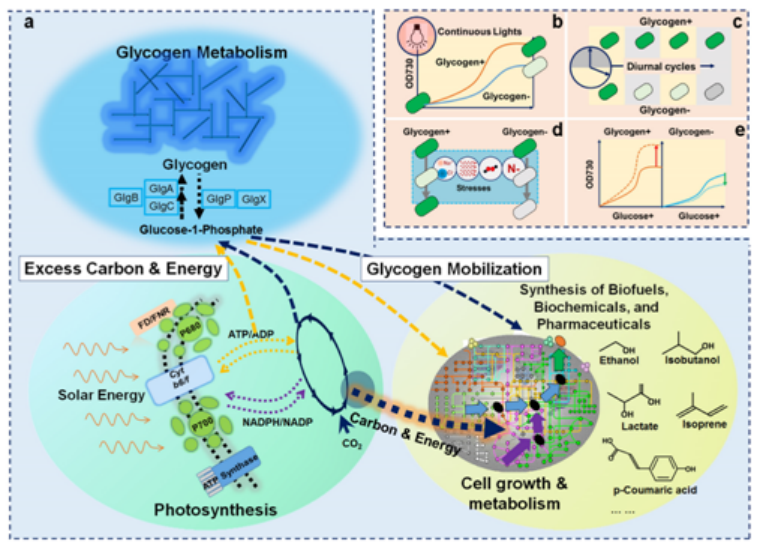Photosynthetic bio-manufacturing refers to the technology of directly converting solar energy and carbon dioxide into biofuels and biochemicals based on photosynthetic organisms. It can simultaneously achieve the effects of carbon sequestration and green production in a single platform and a single process. Cyanobacteria is a highly promising photosynthetic microbial platform. Compared with higher plants and eukaryotic microalgae, cyanobacteria possesses the advantages of relatively simple structure, rapid growth, high photosynthetic efficiency, and convenient genetic manipulations, meaning that it could be easily engineered to be photosynthetic cell factories. An important strategy to develop efficient cyanobacteria cell factories is to redirect more photosynthetic carbon flow into the synthesis of desired metabolites. Glycogen metabolism is an important natural carbon sink mechanism in cyanobacteria, storing the “overflowed” photosynthetic carbon and energy that exceeds the requirements of cell growth and metabolism. Thus lots of strategies and approaches have been developed to knock out or weaken the glycogen synthesis pathway for optimizing the efficacy of cyanobacteria cell factories, however a majority of the attempts proved to be unsuccessful. MME group led by Prof. Xuefeng Lu from the Qingdao Institute of Bioenergy and Bioprocess Technology (QIBEBT), Chinese Academy of Sciences (CAS), made a systematic and comprehensive summary on engineering targets, regulation strategies, physiological influences, and metabolism effects of glycogen metabolism engineering in cyanobacteria, and prospected the future development trends in this area. In a review article recently published in Biotechnology Advances, the scientists proposed that glycogen metabolism played two important roles for cyanobacterial cellular physiology and metabolism (Figure 1): (i) as the essential carbon sink mechanism to accept overflowed carbon and energy from photosynthesis and maintain the dynamical balance between the carbon-energy input and output; (ii) as an important physiological protective mechanism to facilitate the maintaining of cellular homeostasis. Simply removal of glycogen storage in cyanobacteria cell factories would reduce the photosynthesis efficiencies and cellular robustness, finally leading to inhibition of the efficacy of photosynthetic production of the desired metabolites. Thus although the strategies and approaches to regulate glycogen metabolism (synthesis and degradation) in cyanobacteria has been mature and effective, there has still been a long way to go before glycogen metabolism engineering could work as an effective strategy for optimizing efficacy of photosynthetic cell factories. In future, the strategy of glycogen metabolism engineering should be adopted in combination with metabolism rebalancing between the activities of energy/reducing-power, photosynthesis/photorespiration, oxidation/reduction, and synthesis/resistance, in order to significantly improve the performances of cyanobacteria cell factories. Recently, the same team has further published another review article about designing principles and engineering strategies on developing advanced cyanobacteria chassis cells toward the requirements of photosynthetic biomanufacturing in future. In the past decades, the concept of cyanobacterial photosynthetic biomanufacturing has been conceptually demonstrated by the successful synthesis of dozens of natural or non-natural metabolites in cyanobacterial photosynthetic chassis cells. However, the feasibility of cyanobacterial photosynthetic biomanufacturing as an economical competitive routes for green production is still questionable. To date, cyanobacteria-based photosynthetic production performance remains far less robust than that of conventional biorefinery technologies. Heterologous microbial cell factories are capable of product titers on the order of 100 g/L and productivities surpassing 1000 mg/L/h, while the parameters of cyanobacterial cell factories are generally lower than 10 g/L and 10 mg/L/h, respectively has an order of magnitude difference in production and production intensity compared to the classical heterotrophic cell factories (E. coli, yeast, lactic acid bacteria, Bacillus subtilis, etc.). Fundamentally, the overall performances of cyanobacterial photosynthetic cell factories are limited by photosynthesis efficiencies of the chassis cells, thus improved photosynthesis capacities is critical to unlock the full potentials of cyanobacterial photosynthetic biomanufacturing. In recent years, the rapid accumulation of massive system biology data and development of efficient synthetic biotechnology tools have shed light on deep understanding and comprehensive engineering of the photosynthesis mechanisms in cyanobacteria. In addition, the discovery and identification of novel cyanobacteria species with unprecedented growth rates and tolerances to high light and high temperatures also provide more inspirations for modifying and redesigning the cyanobacterial photosynthesis systems. In the article published in Current Opinion in Biotechnology, the scientists summarized and compared recent progress on the above two aspects. From the levels of light energy utilization and carbon dioxide sequestration, six engineering strategies were summarized, including “spectral expansion for solar energy capture”, “antenna reduction for strong illumination tolerance”, “electron transport chain optimization”, “enhancement of carbon concentration & absorption activity”, “enhancement of carbon fixation activity”, and “reduction of carbon loss” (Figure 2). Focusing on the industrial application of cyanobacterial photosynthetic biomanufacturing, the development of “smart sensing” and “rapid responsive” system should also be taken into consideration, which would enable the cyanobacteria chassis cells and engineered strains to flexibly adapt to the changing and harsh environmental conditions and to dynamically balance the carbon distribution between cell maintenance and photosynthetic production. The related work was supported by the National Natural Science Foundation of China, the Shandong Natural Science Foundation, and Strategic Priority Research Program of the Chinese Academy of Sciences. Figure 1. The physiological and metabolic significance of glycogen metabolism in cyanobacteria Figure 2. Understanding and engineering strategies for improving cyanobacterial photosynthesis (Images and text by Guodong Luan) References 1. Guodong Luan*, Shanshan Zhang, Min Wang, Xuefeng Lu*, 2019, Progress and perspective on cyanobacterial glycogen metabolism engineering, Biotechnology Advances, https://doi.org/10.1016/j.biotechadv.2019.04.005. Links: https://linkinghub.elsevier.com/retrieve/pii/S0734-9750(19)30064-3 2. Guodong Luan#,Shanshan Zhang#,Xuefeng Lu*, 2019, Engineering cyanobacteria chassis cells toward more efficient photosynthesis, Current Opinion in Biotechnology, doi: 10.1016/j.copbio.2019.07.004. Links: https://www.sciencedirect.com/science/article/pii/S0958166919300473?via%3Dihub.







